Review: Click ’N Design 3D CD/DVD Labeling Software

Developer: Stomp, Inc.
Price: $14.95 (download); $27.17 (CD + shipping)
Requirements: PowerPC-based Mac with Mac OS 8.6 or Mac OS X, 30 MB free disk space (320 MB for all the clip art), 800x600 display, printer that can handle label stock.
Recommended: 64 MB application RAM, QuickTime 5.
Trial: Fully-featured (30 days).
Overview
Click ’N Design 3D lets you create fancy disc labels and jewel case liners and inserts. It supports label sheets from many vendors. It has a large clip art and photo collection for creating backgrounds and foreground art. It also includes tools for creating and modifying text with 3D effects.
Installation
Double-click on the “Install Click ’N Design 3D.app” icon to launch the installer. Click the Agree button after reading or ignoring the lengthy license agreement. You have options for installing the application (48 MB) and two clip art collections (100 MB and 253 MB). If QuickTime 5.02 is not installed, you may select that option, too. The application and clip art files can be installed in any folder on any hard drive.

Installer Options Window
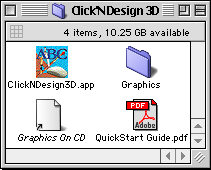
Click ’N Design Folder with Clip Art Installed
Using Click ’N Design 3D
Each time you launch the application, you encounter a window that forces you to select a label type from the pop-up menu and label vendor from the scrolling list.
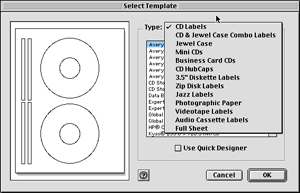
Window for Selecting Label Type and Vendor
The program does not remember your last selection, and you cannot establish default options. If you check the “Use Quick Designer” box, the program switches to the QuickStart Wizard. (I don’t know why Stomp uses Quick Designer and QuickStart Wizard interchangeably.)

QuickStart Wizard for CD Label
The main application consists of a label creation window beneath three collapsible tool bars: an unnamed toolbar (containing file option, view option, and image stacking buttons), a Layout toolbar, and an Object toolbar (with variable contents depending on label type and current task).
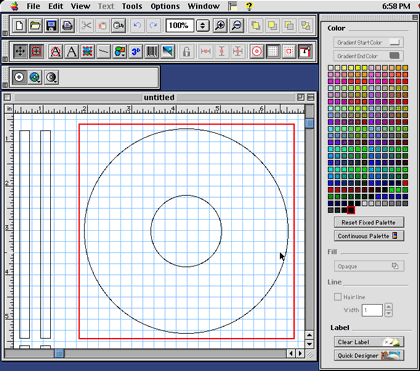
Application Window, Toolbars, and Palettes
The main window shows the chosen template with the default grid setting (blue lines 0.25" apart). The active area for editing is surrounded by a red rectangle. You can add three types of backgrounds: solid fill, gradient fill, or image. Six types of gradient fills are available. Gradient starting and ending colors are selected using the color palette to the right. There are two color palette options: fixed and continuous. The fixed palette contains 256 colors and cannot be altered.

Gradient Fill Options
Click ’N Design comes with a large assortment of background photos, computer art, and textures. Fifty images are uncategorized and are found in the Graphics folder. The Backgrounds folder contains 33 folders of images. Two folders contain textures. The others contain photographs. Themes vary from Architecture to Dog Sledding. Unfortunately, all images, textures, and clip art contain non-descriptive names such as “B0311772.JPG.” Click ’N Design does not include an image catalog program and does not have a printed (or printable) catalog. The only way to identify images or clip art is to preview them in the “Select Image” or “Select Background Image” windows. The default window contains a file list and a button to show or hide a preview window to the right.
The preview changes almost instantly as you highlight different image files by clicking on the file name with the mouse or by navigating through the list with the arrow keys. If you go to the Preferences window and choose “Thumbnail Selector,” then your “Select Image” window will contain three or six thumbnail images below the file list.

Default Image Selection Window with Thumbnail Selector
Unless you have an incredibly fast Macintosh, do not use this option. The Thumbnail Selector initially loads the first six images of the chosen folder. This takes quite a few seconds. As you scroll down the list of image names, more image previews load (slowly). If you change folders, the process begins again. If you go back to the previous folder, those images must reload. This process is not speeded up by giving Click ’N Design more memory, or by putting the images on your hard drive. Images can be used as background or as foreground art. Background images can be resized to fit the label, and small images can be tiled.
You can add three types of text to your labels: plain text, circular text, and 3D text. The plain text tool requires you to create a text box within the active portion of the label template. The text box cannot extend beyond the red bounds. The object toolbar contains text editing tools when the text box is selected.
Object Toolbar with Text Editing Tools
The “T” and “S” icons are pop-up menus for choosing fonts and font styles. Font size can be adjusted with the up and down arrows or by typing a point size into the text size field. The next two toolbar icons are pull-down menus to set text alignment (left, center, right, full) and orientation (normal, up, down, and other [text on a specified angle]). The next two buttons are for setting margins around the text and for editing text contents. When the text box is highlighted, the top rectangular button in the Color palette reads “Text Color.” When that button is active, the text color matches the one chosen in the Color palette.

Circular Text Creation and Editing Window
When you click the “Circular Text” button, a new window appears. Text entered into the field immediately appears in the active portion of the label template. Some icons are the same as those in the plain text toolbar. The text color button (to the right of the Style pull-down icon) pops up a standard Macintosh window for choosing colors.

Color Picker Window
You can use any available method for generating text color (CMYK, Crayon, HLS, HSV, HTML, or RGB Picker). However, if you wish to exactly match the color of plain text, then you should use one of the 256 fixed colors from the Color palette. The button to the right of the color icon toggles “Center Text” on and off. When “Center Text” is off, you can shift the circular text within the active label. When “Center Text” is on, you can only change the diameter of the circular text (the center point is fixed). The button with the letter “T” over an arc toggles convex and concave text. The Trash Can button deletes the circular text from the active label area. The orientation point for the text can vary between 0 and 360 degrees.
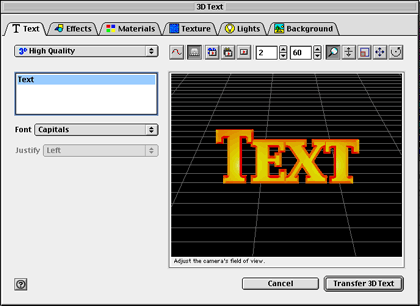
Window for Creating and Editing 3D Text
3D text creation is done in a separate modal window with six tabs. The upper part of the window contains buttons and numeric fields for entering zoom factor and camera distance. Tab-specific items appear on the left, and the 3D text appears on a grid to the right. With the Text tab active, you enter text into the field on the left. You can choose a font and a justification, but you cannot choose a font style (such as bold or italic). You also cannot adjust kerning, a major omission when working with 3D text. Otherwise, Click ’N Draw 3D gives you complete control over your 3D text. You can apply a variety of effects (arc, arch, bow, bubble, circle, curve, perspective, slant, and wave). You can change extrusion and bevel settings, adjust curvature of circles and arcs, apply and position one to four light sources, use a variety of materials such as gold or chrome, apply textures (including the use of images as textures), and select from solid, gradient, or image backgrounds. In addition, you can edit 3D text blocks or individual characters via Bézier curve handles.

Editing 3D Text Using Bézier Curve Handles
You can also edit the shape and 3D orientation of individual font characters and have those changes apply to every instance of the character in your text. Editing via Bézier curves and X, Y, Z position settings requires time and some trial and error (thankfully, there is a reset button), but it isn’t difficult. When you have finished editing your text and adjusting camera position (which also controls the overall size of the 3D text object), clicking on the “Transfer 3D Text” button places the text block onto the active label.
Problems, Bugs, and Omissions
Other than the quirky interface and slow thumbnail image browser, I encountered no problems with Click ’N Design 3D. An obvious omission is the lack of support for drag and drop. (The program does support cut and paste.)
Documentation
The CD comes with a two-page “Quick Start Guide for Macintosh.” On the CD is a PDF file for a 20-page (6" by 9") “QuickStart Guide.” Both manuals are solely for the Macintosh version, a welcome feature for a product ported from a Windows-based predecessor. The manual begins with brief descriptions of how to create disc labels and jewel case inserts using the QuickStart Wizard. Then there is a series of “Did you know…?” tips covering image and text manipulations. I disliked this approach in a manual, especially when many of the menu and toolbar items were not even described. However, these items are described (very briefly) in the online help screens. Although the Help guide is being used in place of a more detailed manual, it doesn’t function like a manual. You cannot move sequentially through the help screens and must keep returning to main topic or subtopic screens to switch topics.
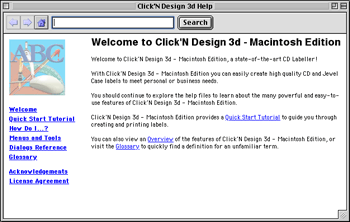
Help Viewer Window with Topic List
Technical Support
Stomp maintains a Web site listing of frequently asked questions about Click ’N Design. However, only ten questions are answered. Written support requests via Stomp’s online Web form are free. Telephone support is free for 30 days starting with the first call. After 30 days, telephone support is $20 per incident.
Strengths
- Supports labels and templates from many vendors.
- Large image and clip art collection.
- Ability to create and edit 3D text with advanced features such as light placement, textures, and Bézier curve adjustment of letters and text blocks.
Weaknesses
- No label type and vendor preferences.
- No printed or printable image catalog and non-descriptive image file names.
- Incredibly slow thumbnail image browser, even when images are on hard drive.
- Non-standard interface that is inconsistent and somewhat difficult to use.
- QuickStart Wizard offers very few choices.
- Fragmented documentation with no unified owner’s manual.
Alternatives
Discus 2 from Magic Mouse Productions is another dedicated disc labeling application. An OEM version (with less clip art and no minidisc templates) is bundled with Toast 5 Titanium from Roxio (see ATPM review). Although it has its own interface quirks, Discus allows faster creation of disc labels and jewel case liners and book inserts. It can import audio CD track names from Toast. Discus costs $39 ($20 if upgrading from the Roxio OEM version).
Most drawing programs, such as Deneba’s Canvas, Adobe Illustrator, and CorelDraw, support label templates. With one of those programs and some clip art collections, you can create disc labels and jewel case liners almost as readily as with Click ’N Design 3D.
Another alternative is Nova Development’s Print Explosion Deluxe ($60). It has CD label templates and an extensive clip art and image collection. This program helps you create greeting cards, stationery, envelopes, banners, signs, labels, certificates, paper airplanes, etc.
Summary
Click ’N Design 3D subjects users to an awkward and inconsistent interface. The program would have received a “Rotten” rating if usability were my main criterion. However, the program is very inexpensive ($27.17 with shipping). The clip art and 3D text creation capabilities alone might be worth that much to some users, so I give the program an “Okay” rating.
Reader Comments (79)
Corbin Harris
Corbin: This isn't unusual. Most people who use a program like Click 'N Design 3D will be printing labels on an inkjet printer. Creating PostScript code for 3D stylized text would require a big addition to the program, and probably would not generate a sufficient return on investment. (Remember, this program can be downloaded for only $15.)
W. W.
I know this isn't a great help, but the calibration "feature" of Click 'N Design is badly implemented. That's why I stick with a competing product.
Charlie, Happy Faces Productions
Hopefully, Norm Hallett
Note: This is formatted to work with my printer, and using another may vary the placement of the outlines.
"Just install the program, then right-click on the icon and select 'Show package contents.' Then go to Contents --> MacOS and get info on ClickNDesign3D, and check "Open in the Classic environment." Then, put that generic-looking icon in the Dock. You must click that icon to open the program. The original icon will try to open the program in Panther, which currently does not work."
To be able to print, I dug out my printer's installation disk and installed my printer in Classic. Fortunately for me, the disk came with two installers -- one for OS X and another for OS 9. When I clicked on the one for OS 9, it automatically launched Classic, and my printer appeared on my Chooser list. Yay! I have an Epson Stylus Photo 925 and I run Panther on a G5.
If your not prepared to work with the Mac freaks then they dont need our business. I suggest you guys still using it get out there and find an OSX.3 replacement and let us know what it is.
Go to the following for mor information on Discus CD Label Maker:
http://www.magicmouse.com/h_discus_detail.html
Any pointers out there?
Do I have to ghange any settings?
Appreciate a comment.
Jim
I tried reinstalling it and the same thing occurred. Oh, it did open a couple times but I got no further then the first page where the "tips" are and even then there were no tips. Strange...
Please HELP.
Jim
Thanks
I agree with an earlier post, if 26 million people isn't a big enough market share for them -- especially when you realize that a lot of mac people are graphics people and inclined to love a product that lets them play -- then, to hell with them. This puppy goes back to the store tomorrow and I'm looking into other products that were recommended!
There is a download for an update, but it is only for PC.
Oh well! I think we should all take this product back to the store and make sure the store knows why. Then the store can send all the products back to CDStomper.
Hey -thanks for having this site - very cool. I found you when i was doing a search on CD Stomper.
Most portions of the site would have me believe they're only selling Windows versions now, but the FAQ page does mention Macintosh system requirements. Unfortunately, stating that you need "Macintosh PowerPC processor or better, 64 MB RAM (128 MB recommended), Mac OS 8.6/9.2/X.1" doesn't really have me believing the software is Mac OS X-native. Hopefully someone will soon be able to check out this new development and let us all know the status of the Mac version.
they sent me this:
If you would like to obtain this upgrade - call them at 503-469-3301 between 7:00am - 7:00pm CST, Monday - Friday or you may fax your request to 503-574-1330.
Cheers, Beth
Can you give us any other news since your last post? Did you receive the update? How does it work?
Anyone else tried with success?
Due to lack of OS X 10.3 support I am moving over to use the Toast 6 Titanium's CD Label printing software. I have only made 1 label so far but it was very easy and seemed fairly full featured.
hey everybody...
Like most of you I found this website while looking for info on this crappy product... as much as It's been a hassle, I like the program... now, at first I would have to change start up disks to use it because I was desperate and needed to use for school... but thanks to "Suzi", her post has taught me how I can run it in Classic. When the Real Panther update is available I'll be the first in line but until then nothing beats a CLASSIC!!
SCROLL UP FIND SUZI's POST AND YOURE DONE
(at least for now... lol)
Thanks!
From a post on the Macdiscussion website (http://www.macdiscussion.com) I found that Cdstomper (Avery) has an update to the Click 'n Design software that will enable it to run on OS 10.3.X . I called their tech support (530) 469-3301 they said that they would send me a CD of the new version, should take a couple of weeks. Strangely the website make no mention of the OS problem or that there is a remedy. I hope this will take care of the OS problem
thanks
Can anyone help please?
Thanks
I have now gone on to use Panther on my desk top and Tiger on my lap top, plus i have set up my home with an Airport Card.
Now, when I go back to 9.2, Click & Design will not print; what gives?
Alan Rock
Any ideas?
My installed Click'n Design 3D cannot be accessed on my computer. Clicking the icon no longer loads the program. I have uninstalled Click'n Design 3D, and reinstalled it to no avail.
Help!
As is true for any operating system upgrade, it is very important to make a list of all your software that you rely on prior to upgrading, and confirm there are versions (even if it's the current version) that work properly on the new operating system. It's near-suicide to upgrade an OS and blindly assume all your apps will continue to work. Many will, but it shouldn't be assumed.
The CD arrived today, and it installed and launched on 10.4 without any problems! So if you have a previous version of this software, and need an update for 10.4, I urge you to fill out the form.
thanks
Yours truly,
anika
Just downloaded and installed the Mac version from the Stomper site download page. (Oct 10/06)
http://www.cd-stomper.com/downloads/downloads_cnd.html
Installed and booted up no problem. and appears to be working fine with Tiger OSX 10.4.7. (on a G3 iMac)
It does seem to be having some problems importing "circular text" that I had around the outside edge on some of my old label files, it says:
"Unkown error at line 897 in "CircularTextObject.cpp".
But it does still load the file, just without the circular text.
Also the background image is missing on some. (Perhaps my files are corrupted.) It has crashed a couple times, but the OS9 version used to do that too so nothing new there. Needless to say, haven't had much time to test it properly, but it does run and everything looks okay.
Anyway, give it a shot, perhaps it will work you.
I just called tech support from ATPM Staff's post above and found that the newest version (at the time of this post) is 5.0 and it only works for Macs 10.4.4 and above. So apparently they took all that time between the making of the last 10.2 version and 10.4.4 to figure out that people still wanted the software. As an owner of 10.3.9 I'm out of luck unless I find an old version of the software that was compatible with this system. Does anyone know what this is?
I don't want to look forward to getting my computer upgraded again just so I can use this program. I'd rather have a version now that works and lets me recover my old Click N' Design projects that I will still use in the future.
This calibration is not, as you say, EASY. Please advise. I am using MAC leopard operating system.
Thanks
Sent email to customer support guy but didn't get any help. I believe I felt cheated by this worst software ever had.
Add A Comment